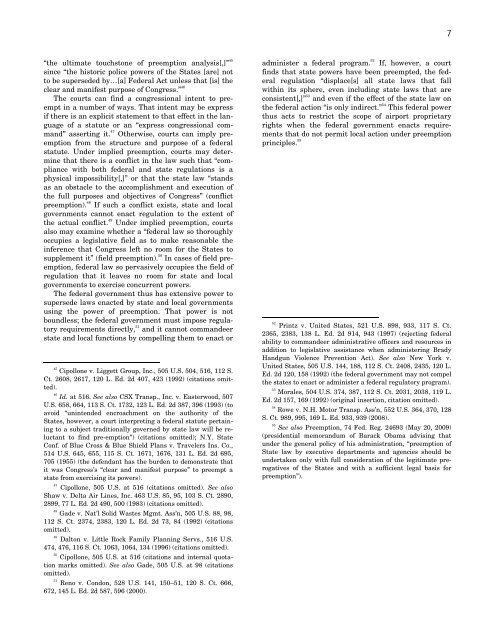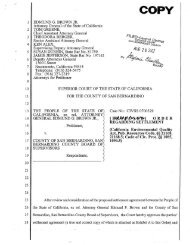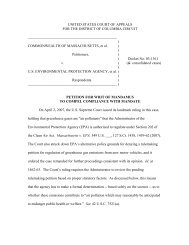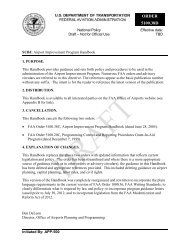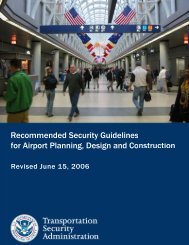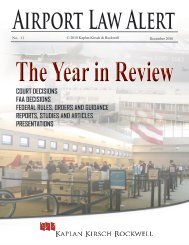ACRP Legal Research Digest 10
ACRP Legal Research Digest 10
ACRP Legal Research Digest 10
You also want an ePaper? Increase the reach of your titles
YUMPU automatically turns print PDFs into web optimized ePapers that Google loves.
7<br />
“the ultimate touchstone of preemption analysis[,]” 45<br />
since “the historic police powers of the States [are] not<br />
to be superseded by…[a] Federal Act unless that [is] the<br />
clear and manifest purpose of Congress.” 46<br />
The courts can find a congressional intent to preempt<br />
in a number of ways. That intent may be express<br />
if there is an explicit statement to that effect in the language<br />
of a statute or an “express congressional command”<br />
asserting it. 47<br />
Otherwise, courts can imply preemption<br />
from the structure and purpose of a federal<br />
statute. Under implied preemption, courts may determine<br />
that there is a conflict in the law such that “compliance<br />
with both federal and state regulations is a<br />
physical impossibility[,]” or that the state law “stands<br />
as an obstacle to the accomplishment and execution of<br />
the full purposes and objectives of Congress” (conflict<br />
preemption). 48<br />
If such a conflict exists, state and local<br />
governments cannot enact regulation to the extent of<br />
the actual conflict. 49<br />
Under implied preemption, courts<br />
also may examine whether a “federal law so thoroughly<br />
occupies a legislative field as to make reasonable the<br />
inference that Congress left no room for the States to<br />
supplement it” (field preemption). 50 In cases of field preemption,<br />
federal law so pervasively occupies the field of<br />
regulation that it leaves no room for state and local<br />
governments to exercise concurrent powers.<br />
The federal government thus has extensive power to<br />
supersede laws enacted by state and local governments<br />
using the power of preemption. That power is not<br />
boundless; the federal government must impose regulatory<br />
requirements directly, 51 and it cannot commandeer<br />
state and local functions by compelling them to enact or<br />
45<br />
Cipollone v. Liggett Group, Inc., 505 U.S. 504, 516, 112 S.<br />
Ct. 2608, 2617, 120 L. Ed. 2d 407, 423 (1992) (citations omitted).<br />
46 Id. at 516. See also CSX Transp., Inc. v. Easterwood, 507<br />
U.S. 658, 664, 113 S. Ct. 1732, 123 L. Ed. 2d 387, 396 (1993) (to<br />
avoid “unintended encroachment on the authority of the<br />
States, however, a court interpreting a federal statute pertaining<br />
to a subject traditionally governed by state law will be reluctant<br />
to find pre-emption”) (citations omitted); N.Y. State<br />
Conf. of Blue Cross & Blue Shield Plans v. Travelers Ins. Co.,<br />
514 U.S. 645, 655, 115 S. Ct. 1671, 1676, 131 L. Ed. 2d 695,<br />
705 (1955) (the defendant has the burden to demonstrate that<br />
it was Congress’s “clear and manifest purpose” to preempt a<br />
state from exercising its powers).<br />
47<br />
Cipollone, 505 U.S. at 516 (citations omitted). See also<br />
Shaw v. Delta Air Lines, Inc. 463 U.S. 85, 95, <strong>10</strong>3 S. Ct. 2890,<br />
2899, 77 L. Ed. 2d 490, 500 (1983) (citations omitted).<br />
48<br />
Gade v. Nat’l Solid Wastes Mgmt. Ass’n, 505 U.S. 88, 98,<br />
112 S. Ct. 2374, 2383, 120 L. Ed. 2d 73, 84 (1992) (citations<br />
omitted).<br />
49<br />
Dalton v. Little Rock Family Planning Servs., 516 U.S.<br />
474, 476, 116 S. Ct. <strong>10</strong>63, <strong>10</strong>64, 134 (1996) (citations omitted).<br />
50<br />
Cipollone, 505 U.S. at 516 (citations and internal quotation<br />
marks omitted). See also Gade, 505 U.S. at 98 (citations<br />
omitted).<br />
51<br />
Reno v. Condon, 528 U.S. 141, 150–51, 120 S. Ct. 666,<br />
672, 145 L. Ed. 2d 587, 596 (2000).<br />
administer a federal program. 52<br />
If, however, a court<br />
finds that state powers have been preempted, the federal<br />
regulation “displace[s] all state laws that fall<br />
within its sphere, even including state laws that are<br />
consistent[,]” 53 and even if the effect of the state law on<br />
the federal action “is only indirect.” 54 This federal power<br />
thus acts to restrict the scope of airport proprietary<br />
rights when the federal government enacts requirements<br />
that do not permit local action under preemption<br />
principles. 55<br />
52<br />
Printz v. United States, 521 U.S. 898, 933, 117 S. Ct.<br />
2365, 2383, 138 L. Ed. 2d 914, 943 (1997) (rejecting federal<br />
ability to commandeer administrative officers and resources in<br />
addition to legislative assistance when administering Brady<br />
Handgun Violence Prevention Act). See also New York v.<br />
United States, 505 U.S. 144, 188, 112 S. Ct. 2408, 2435, 120 L.<br />
Ed. 2d 120, 158 (1992) (the federal government may not compel<br />
the states to enact or administer a federal regulatory program).<br />
53<br />
Morales, 504 U.S. 374, 387, 112 S. Ct. 2031, 2038, 119 L.<br />
Ed. 2d 157, 169 (1992) (original insertion, citation omitted).<br />
54<br />
Rowe v. N.H. Motor Transp. Ass’n, 552 U.S. 364, 370, 128<br />
S. Ct. 989, 995, 169 L. Ed. 933, 939 (2008).<br />
55<br />
See also Preemption, 74 Fed. Reg. 24693 (May 20, 2009)<br />
(presidential memorandum of Barack Obama advising that<br />
under the general policy of his administration, “preemption of<br />
State law by executive departments and agencies should be<br />
undertaken only with full consideration of the legitimate prerogatives<br />
of the States and with a sufficient legal basis for<br />
preemption”).


